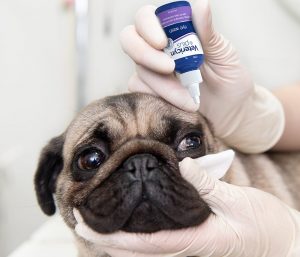Let’s face it, animals get hurt. As pet owners, we need to be prepared to care for and treat minor animal injuries at home. To help, we made this short video on what we’d put in a pet first aid kit.
We hope this video gives you an idea of what to consider for your own pet first aid kit at home.
Below is a more detailed list of the products we used in the video. To learn more, read our recent blog post on what to include in a basic pet first aid kit.

Basic pet first aid kit items. Don’t forget items unique to your pet!
1. Collapsible Bowl: for feeding and hydrating animal in case of emergency or transportation
2. Ice Pack: relieve pain, swelling, and inflammation
3. Vetericyn Plus Antimicrobial Ophthalmic Gel to relieve eye irritation and provide relief to serious eye ailments
3. Vetericyn Plus Antimicrobial Ear Rinse to rinse our foreign bodies or contact with harmful substances
3. Vetericyn Plus Antimicrobial Eye Wash to flush eyes of debris or smoke
3. Vetericyn Plus Antimicrobial Wound & Skin Care liquid to clean wounds, cuts, abrasions, and scrapes, and jumpstart healing
4. Tongue Depressors: to examine the throat or mouth
5. Cotton Swabs: for cleansing, removal of debris, and applying topical medications
6. Tweezers: to remove debris like glass, dirt, ticks, or foxtails
7. Abdominal Gauze Pad: to treat excessive bleeding or to apply ointments or to clean wounds
7. Sterile Gauze Pad Large: to treat excessive bleeding or to apply ointments or to clean wounds
7. Sterile Gauze Pad small: to treat excessive bleeding or to apply ointments or to clean wounds
7. Sting Relief pads: provides temporary relief from pain from insect stings
7. Alcohol Pad: clean tools before use
7. Soap Wipes: to use for the person providing aid
8. Adjustable Muzzle: to restrain pet in case of injury or transporting
9. Electrolytes: to replace potassium
10. Vet Wrap: for wrapping, securing wounds or creating tourniquets
11. Canned Food: in case of shortage
12. Emergency Potty Pads: in case of defecation
13. Disposable Gloves: to protect yourself from body fluids
14. Thermal Blanket: to maintain body heat
15. Oral Syringe: to give oral treatments
16. Eye droppers: use to flush out wounds
17. Scissors: to cut medical tape, splints, or any other type of bandaging material
18. Pet Emergency Card: has veterinarian information and poison control information
19. Medical Tape: used to secure gauze pads or wraps
20. Treats: for distraction or rewarding bravery
21. Hollow Treats: for ease of taking pills
22. Storage Bag: a place to keep emergency supplies in
23. Old Towel: to wrap animal in to calm them down or to use as a soft surface if ground is too hot or hard
Remember to always follow up with your veterinarian after your pet has had an injury and seek immediate medical attention if an injury is too severe for your first aid kit.


